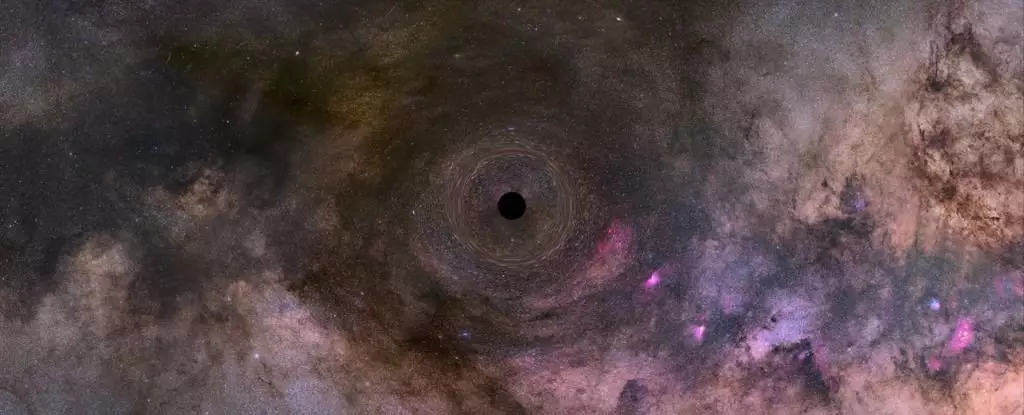In a dramatic astronomical revelation, scientists have confirmed the existence of a lone black hole traversing the vast cosmos, a phenomenon that shatters our preconceived notions of these enigmatic entities. Typically, black holes are found in celestial duets, often hidden in the shadow of their brilliant stellar companions. However, this solitary black hole—estimated at approximately 7.15 solar masses and situated around 4,958 light-years from Earth—has chosen to abide in solitude, moving through space at a remarkable speed of about 51 kilometers per second. This finding not only serves as a testament to the richness of our universe but is critical in refining our understanding of black hole formation and their elusive nature.
Gravitational Microlensing: A New Perspective
The black hole’s presence was unveiled through a phenomenon known as gravitational microlensing, where its profound gravitational field warps the light emitted from a more distant star. As this warping occurs, the star’s light becomes amplified, crafting a fleeting change in its apparent position in the night sky. This mechanism allows astronomers to discern the existence of a dark object without relying on traditional methods, such as detecting emitted radiation, which makes this solitary black hole not only intriguing but pivotal in advancing stellar astrophysics.
The recent identification of this black hole exemplifies the duality of light and gravity, challenging previous methodologies in black hole detection. While conventional methods usually rely on observing the influence of a black hole on nearby stars or the gravitational waves released during their mergers, this discovery pushes the boundaries of astrophysical techniques. It compels us to reconsider the strategies employed in hunting down these cosmic phenomena, suggesting that a larger population of solitary black holes may exist undetected in the universe.
A Complicated Journey to Identification
The journey to identifying this solitary black hole was anything but straightforward. Initial observations emerged in 2011 from the Optical Gravitational Lensing Experiment (OGLE) and the Microlensing Observations in Astrophysics (MOA). The challenge lay not only in gathering data but also in distinguishing the faint cosmic signals from overwhelming brightness from neighboring stars. The data amassed over multiple years, including eight observations from the Hubble Space Telescope and contributions from 16 other telescopes, eventually pointed to a stellar-mass black hole. However, an analysis in 2022 threw a wrench into the works, suggesting a neutron star might be responsible due to a revised mass estimate.
In the face of conflicting conclusions, ongoing scientific inquiry prevailed. Further investigations, including follow-up studies from both the neutron star team and the initial researchers, gradually strengthened the original hypothesis. The recent, thorough analysis incorporated additional Hubble observations over 11 years, ultimately reaffirming its black hole status and presenting enhanced accuracy. This episode illustrates the nature of scientific discourse—a pulsating dance of evidence, hypothesis, and reinterpretation that ultimately leads to greater truth.
Challenges and Implications of Observational Astronomy
One major hurdle faced by researchers was the need to discount the light interference from a bright neighbor, necessitating painstaking calculations for each observation to unearth the subtle signature of the black hole. This technical obstacle is a common theme in observational astronomy, urging scientists to develop more sophisticated tools and techniques to extract pertinent information from the cosmos. Moreover, despite having confirmed its solitude, extensive searches revealed no companions larger than 0.2 solar masses within a significant radius, reinforcing the notion that black holes can thrive in isolation, contrary to the narrative that they often exist in binaries.
The Rogue Black Hole: A Testament to the Unknown
While this solitary black hole is the first of its kind to be confirmed, it represents a mere glimpse into the broader population of possibly unseen rogue black holes scattered throughout the universe. Their existence invites profound questions about the life cycles of stars and the dark matter that forms the structural backbone of our cosmic neighborhood. Each solitary presence not only expands our understanding of celestial behavior but also compels astrophysicists to rethink the dynamics that govern black hole formation and evolution.
In a universe that is perpetually changing, the discovery of this lone black hole encapsulates both the journey and the mystery that underscore the study of cosmic phenomena. As we look to the night sky and ponder our existence, we are reminded that even the darkest beings harbor stories waiting to be uncovered.


Leave a Reply